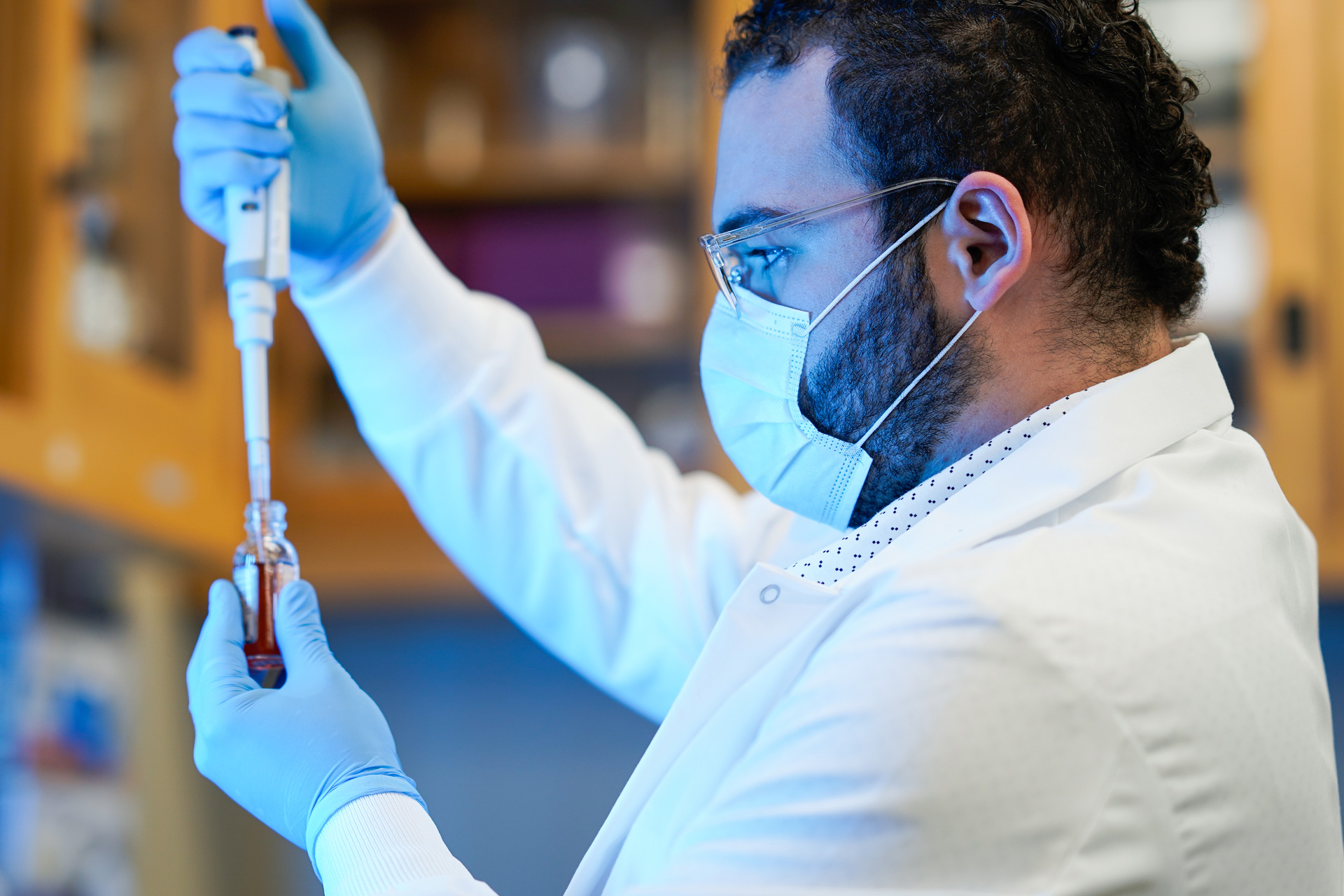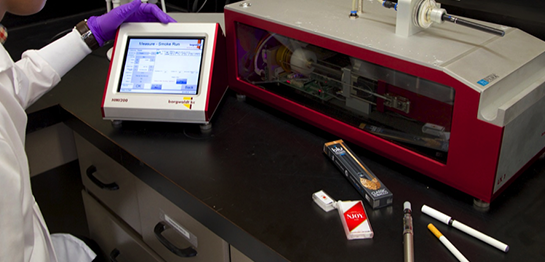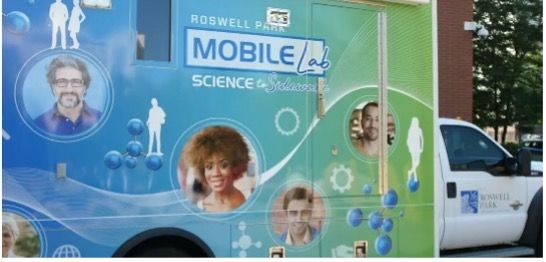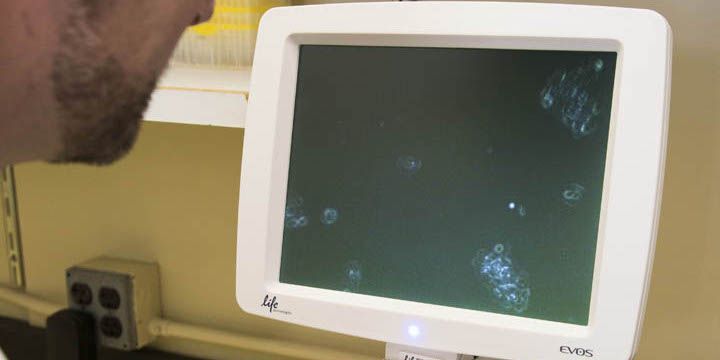What we do
The Nicotine & Tobacco Product Assessment Resource (NicoTAR) at Roswell Park Comprehensive Cancer Center provides comprehensive testing of tobacco and nicotine-containing products to determine the concentration of nicotine and known carcinogens. In addition to product testing, NicoTAR provides analysis of biomarkers of tobacco use and exposure to second- and third-hand tobacco smoke, along with monitoring of indoor air pollution with tobacco products. The NicoTAR facility is equipped with systems for controlled exposure of cells and living tissue to tobacco smoke and e-cigarette emissions. Facility personnel also provide NicoTAR services such as user training, data acquisition, processing and interpretation.
Tools and equipment
Product testing
- Smoking machines and ENDS aerosol generators
- Gas Chromatography (GC)
- Quantitative Time of Flight (QTOF)
- Mass Spectroscopy (MS)
- Nitrogen Phosphorus Detector (NPD)
- pH and density meters
- Ventilation and pressure drop testers
- Paper porosity testers
- Tobacco moisture analyzer
- Tobacco conditioner
Human studies
- Biomarker analysis
- Mobile laboratory
- Negative pressure exposure rooms
- Spirometer
- Airway inflammation monitor
- Smokerlyzer
- Vital sign monitors
- CO monitors
- Puffing topography monitors
In vitro toxicity
- Air liquid interface system
- 96-well plate reader 200-1000nm
- 96-well plate washer
- Live cell and compound microscopes
- Cell counter
- Repository of oral and pulmonary cell lines
Environmental monitoring
- Personal aerosol monitors (total inhalable fraction, respirable fraction or PM2.5 and PM10)
- Particle counters
- Indoor air quality monitors
- Sorbent tube sampling pumps
- Personal environmental monitors
- Primary flow calibrators
- Micro balances
Services and fees
NicoTAR services can be provided by facility personnel:
- Assistance in the selection, design and execution of NicoTAR experiments
- Assistance in processing and interpreting NicoTAR data
- Training and instruction for all users
NicoTAR provides comprehensive testing of all tobacco products including:
- Electronic cigarettes (e-liquids and aerosol)
- Combustible tobacco products (cigarettes, cigars, shisha, mainstream, sidestream and secondhand smoke etc.)
- Heat-not-Burn (HnB) products (tobacco plug and emissions)
- Smokeless tobacco products (chewing, snus, snuff etc.)
- Nicotine Replacement Therapy (NRT) products (patches, gums, lozenges, etc.)
- Oral Nicotine Products (ONP), (pouches, lozenges etc)
- Synthetic nicotine products (e-liquids, ONP etc.)
Product testing
- Nicotine Type (Freebase vs Salt) and Quantification
- Solvent Identification and Quantification
- Flavoring Identification and Quantification
- Tobacco Specific Nitrosamine (TSNA) Quantification
- THC and CBD Potency in Cannabis Products
- Heavy Metal Quantification
- pH and Density Testing
- Heavy Metal Testing
- Tobacco Moisture
- Cigarette Ventilation and Pressure Drop
- Cigarette Paper Porosity
Human studies
- Nicotine, Cotinine and 3OH-Cotinine Quantification (Urine, Plasma, Serum, Saliva, biomarkers of nicotine exposure)
- NNAL Quantification (Urine, biomarker of tobacco exposure)
- THC/THCA and CBD/CBDA Quantification (biomarker of cannabis use)
- Randomized Clinical Trials (product switching, smoking cessation)
- Smoking/Vaping Sessions in Controlled Environment
- Carbon Monoxide Quantification (exhaled breath, verification of smoking status)
In vitro toxicity
- Cytokine and Chemokine Quantification
- Cell Cytotoxicity Testing
Environmental monitoring
- Markers of Indoor Air Quality (IAQ)
- Particulate Measurements (Total Inhalable, Respirable or PM2.5 and PM10)
- Quantification of Smoke/Aerosol in Air (Secondhand Smoke)
- Quantification of Deposited Nicotine (Thirdhand Smoke)
Hourly charge rates for service and usage
Please contact Maciej Goniewicz, PhD, at Maciej.Goniewicz@RoswellPark.org for detailed charge rates. Investigators are billed on a monthly basis for equipment use and services provided.
Scheduling and ordering
Investigators should contact Dr. Goniewicz at Maciej.Goniewicz@RoswellPark.org before submitting any samples, to discuss the assay required and timeframe for competition of requested tasks.
Investigators should contact Noel Leigh at Noel.Leigh@RoswellPark.org for scheduling information, including use of the GC-NPD, GC-MS, GC-QTOF, LC-MS/MS, AAS, smoking rooms, smoking machines or workstations.
Location and hours
Roswell Park Comprehensive Cancer CenterNicoTAR Shared Resource
Gratwick Basic Science Building, Room 4942
Elm and Carlton Streets
Buffalo, New York 14263
Monday - Friday, 8:30 a.m. - 5 p.m.
Meet our team
Noel Leigh, MS
HRI Scientist
Phone: 716-845-8685
Email: Noel.Leigh@RoswellPark.org
Michelle Page, BA
Senior Research Specialist
Phone: 716-845-4910
Email: Michelle.Page@RoswellPark.org
Ashleigh Block, MS
Senior Research Associate
Phone: 716-845-6791
Email: Ashleigh.Block@RoswellPark.org
The services provided by Roswell Park Comprehensive Cancer Center’s Nicotine & Tobacco Product Assessment Resource Facility (NicoTAR) are intended solely for research purposes and are not intended or certified by the New York State Department of Health for use in clinical diagnostic testing or treatment, including but not limited to patient education. Roswell Park shall have no liability for claims by, or damages of any kind whatsoever to, a user of these NicoTAR Facility Services for a decision or action taken in reliance on the information provided. Such damages include, without limitation, direct, indirect, special, incidental or consequential damages.
The Nicotine & Tobacco Product Assessment Resource at Roswell Park Comprehensive Cancer Center (NicoTAR) provides instrumentation and services to investigators requiring nicotine and tobacco product testing, biochemical verification of smoking status and assessment of tobacco smoke exposure.
Major instrumentation includes Agilent 6495C Triple Quadrupole Mass Spectrometer with1290 Infinity II ultra-high performance liquid chromatography system, Sciex 6500+ Triple Quadrupole Mass Spectrometer with Shimadzu Nextera X2 ultra-high performance liquid chromatography system, Waters Xevo TQ-XS Tandem Mass Spectrometer with ACQUITY UPLC I-Class liquid chromatography system, Agilent gas GC with quadrupole time-of-flight mass spectrometry (QTOF, 7250), Agilent gas chromatograph (GC, 7890B) with an Agilent mass spectrometer (MS, 5977A), Agilent gas GC with a nitrogen-phosphorus detector (NPD) and a PerkinElmer PinAAcle atomic absorption spectrometer (AAS, 900z). This instrumentation is capable of a wide variety of nicotine and tobacco product testing and tobacco-specific biomarker assessment. Application examples include determination of nicotine, carcinogens, and flavorings in tobacco products and electronic cigarettes, as well as tobacco-specific biomarkers in biofluids.
NicoTAR data processing software includes Open Lab CDS, SPSS, R, Statistica and GraphPad. A variety of laboratory equipment is available for sample preparation and storage (e.g., smoking machines, puffing monitors, cigarette ventilation and pressure drop tester, cigarette paper porosity tester, air-liquid, etc.) In addition to the facility directors and technicians, Roswell Park Comprehensive Cancer Center provides additional staff who aid in facility maintenance and repair (mechanical, cryogenic, electronic, IT).
- Cox et al. An exploration into “Do-It-Yourself” (DIY) e-liquid mixing: Users’ motivations, practices and product laboratory analysis.Prev Med Rep. 2019;9: 100151
- Dunbar et al. Lead levels in selected electronic cigarettes from Canada and the United States. Int J Environ Res Public Health. 2018;15:154.
- Czoli et al. E-cigarette nicotine content and labelling practices in a restricted market: Findings from Ontario, Canada. Int J Drug Policy. 2018;58:9-12.
- Leigh et al. Tobacco-Specific Nitrosamines (TSNA) in Heated Tobacco Product IQOS. Tob Control. 2018;27(Suppl 1):37-8.
- Goniewicz et al. High exposure to nicotine among adolescents who use JUUL and other vape pod systems (“pods”). Tob Control 2019;28:676-677.
- Kulak et al. Nicotine and pH levels in waterpipe tobacco. Tob Reg Sci. 2017;3:102-7.
- Goniewicz et al. Nicotine levels in electronic cigarette refill solutions: A comparative analysis of products from the US, Korea, and Poland. Int J Drug Pol. 2015;26:583-8.
- Leigh et al. Flavorings significantly affect inhalation toxicity of aerosol generated from electronic nicotine delivery systems (ENDS). Tob Control. 2016;25(Suppl 2):ii81-ii87.
- Goniewicz et al. Electronic cigarettes are a source of thirdhand exposure to nicotine. Nicotine Tob Res. 2015;17:256-8.
- Goniewicz et al. Nicotine Content of Electronic Cigarettes, Its Release in Vapour and Its Consistency across Batches: Regulatory Implications. Addiction 109.3 (2014): 500-07.
- Goniewicz et al. Variations in Nicotine Yields between Single Cigarettes. Cent Eur J Public Health 20.1 (2012): 58-61.
- O'Connor et al. Cigarette characteristic and emission variations across high-, middle- and low-income countries. Public Health. 2010 Dec;124(12):667-74 PMID:21030055.
- Cameron et al. Secondhand smoke exposure (PM2.5) in outdoor dining areas and its correlates. Tobacco control 2010; 19(1):19-23
- Sendzik et al. An experimental investigation of tobacco smoke pollution in cars. Nicotine and tobacco research 2009;11(6):627-634
- O'Connor et al. How do different cigarette design features influence the standard tar yields of popular cigarette brands sold in different countries?. Tob Control. 2008 Sep; 17 Suppl 1:i1-5. PMID:18768453.






